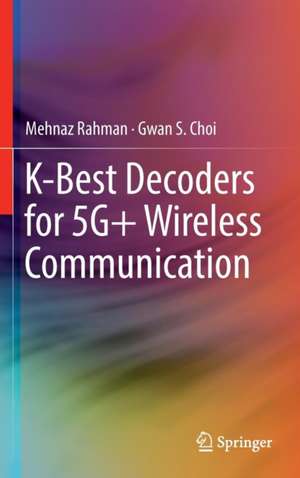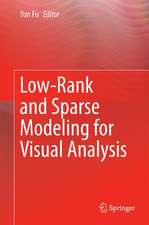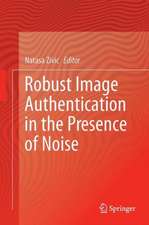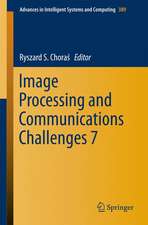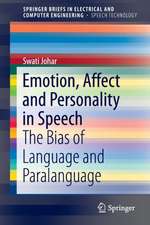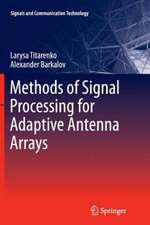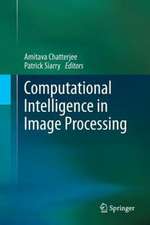K-Best Decoders for 5G+ Wireless Communication
Autor Mehnaz Rahman, Gwan S. Choien Limba Engleză Hardback – 7 sep 2016
| Toate formatele și edițiile | Preț | Express |
|---|---|---|
| Paperback (1) | 375.62 lei 6-8 săpt. | |
| Springer International Publishing – 14 iun 2018 | 375.62 lei 6-8 săpt. | |
| Hardback (1) | 382.75 lei 6-8 săpt. | |
| Springer International Publishing – 7 sep 2016 | 382.75 lei 6-8 săpt. |
Preț: 382.75 lei
Nou
Puncte Express: 574
Preț estimativ în valută:
73.25€ • 79.54$ • 61.53£
73.25€ • 79.54$ • 61.53£
Carte tipărită la comandă
Livrare economică 23 aprilie-07 mai
Preluare comenzi: 021 569.72.76
Specificații
ISBN-13: 9783319428086
ISBN-10: 331942808X
Pagini: 80
Ilustrații: XIV, 64 p. 37 illus., 5 illus. in color.
Dimensiuni: 155 x 235 x 6 mm
Greutate: 0.29 kg
Ediția:1st ed. 2017
Editura: Springer International Publishing
Colecția Springer
Locul publicării:Cham, Switzerland
ISBN-10: 331942808X
Pagini: 80
Ilustrații: XIV, 64 p. 37 illus., 5 illus. in color.
Dimensiuni: 155 x 235 x 6 mm
Greutate: 0.29 kg
Ediția:1st ed. 2017
Editura: Springer International Publishing
Colecția Springer
Locul publicării:Cham, Switzerland
Cuprins
Introduction.- Background.- Real Domain Iterative K-best Detector.- Complex Domain Iterative K-best Decoder.- Fixed Point Realization of Iterative K-best Decoder.- Adaptive Real Domain Iterative K-best Decoder.- Conclusion.- References.
Notă biografică
Mehnaz Rahman completed her Bachelor of Science on Electrical and Electronics Engineering from Bangladesh University of Engineering and Technology in 2011. She is currently doing PhD in Computer Engineering from Texas A&M University, College Station, TX since Fall 2012 under the supervision of Dr. Gwan Choi. Her research interest is focused on algorithmic development and circuit level VLSI design for beyond 5G wireless communication.
After completion of her BSC degree, she worked at Samsung R&D Center, Dhaka, Bangladesh in 2011. She also did summer internships at Intel Research Lab in every year from 2013 to 2015. She has worked as a Teaching Assistant at TAMU for a variety of undergraduate and graduate courses and has been nominated for the Best TA Award during spring 2015. She has received Intel Research Award during her internship in summer, 2013 and Graduate Merit Award at TAMU during fall 2015 for her achievement on research. She has also filed a patent on 5G+ wireless technology with Intel Lab.
Dr. Gwan Choi received his B.S., M.S. and Ph.D. degrees, all in electrical and computer engineering, from the University of Illinois at Urbana-Champaign in 1988, 1989 and 1994, respectively. He currently is an associate professor in the department. He has worked for Cray Research Inc. and Tandem Computers Inc, and he has been a visiting scientist at the NASA Langley Research Center.
Dr. Choi's research interests include fault-tolerance, verification simulation, high-performance VLSI circuits, radiation testing, design for dependability and software engineering. He is a member of Eta Kappa Nu, the IEEE Computer Society, the IEEE technical committee on Fault-Tolerant Computing and the IEEE technical committee on computer architecture.
Dr. Choi also has served as a program committee member on several international conferences and was a vice-chair for the IEEE International Performance and Dependability Symposium, IPDS-2000. He haswon a number of awards including the National Science Foundation's (NSF) career award in 1997.
After completion of her BSC degree, she worked at Samsung R&D Center, Dhaka, Bangladesh in 2011. She also did summer internships at Intel Research Lab in every year from 2013 to 2015. She has worked as a Teaching Assistant at TAMU for a variety of undergraduate and graduate courses and has been nominated for the Best TA Award during spring 2015. She has received Intel Research Award during her internship in summer, 2013 and Graduate Merit Award at TAMU during fall 2015 for her achievement on research. She has also filed a patent on 5G+ wireless technology with Intel Lab.
Dr. Gwan Choi received his B.S., M.S. and Ph.D. degrees, all in electrical and computer engineering, from the University of Illinois at Urbana-Champaign in 1988, 1989 and 1994, respectively. He currently is an associate professor in the department. He has worked for Cray Research Inc. and Tandem Computers Inc, and he has been a visiting scientist at the NASA Langley Research Center.
Dr. Choi's research interests include fault-tolerance, verification simulation, high-performance VLSI circuits, radiation testing, design for dependability and software engineering. He is a member of Eta Kappa Nu, the IEEE Computer Society, the IEEE technical committee on Fault-Tolerant Computing and the IEEE technical committee on computer architecture.
Dr. Choi also has served as a program committee member on several international conferences and was a vice-chair for the IEEE International Performance and Dependability Symposium, IPDS-2000. He haswon a number of awards including the National Science Foundation's (NSF) career award in 1997.
Textul de pe ultima copertă
This book discusses new, efficient and hardware realizable algorithms that can attain the performance of beyond 5G wireless communication. The authors explain topics gradually, stepping from basic MIMO detection to optimized schemes for both hard and soft domain MIMO detection and also to the feasible VLSI implementation, scalable to any MIMO configuration (including massive MIMO, used in satellite/space communication). The techniques described in this book enable readers to implement real designs, with reduced computational complexity and improved performance.
Caracteristici
Discusses algorithmic development of MIMO detection in both real and complex domains Uses lattice reduction (LR) and Schnorr Euchner (SE) enumeration in order to reduce computational complexity Includes detection schemes applicable and scalable to any MIMO configuration (even for massive MIMO), which comply with IEEE standards of beyond 5G wireless communication Includes supplementary material: sn.pub/extras
